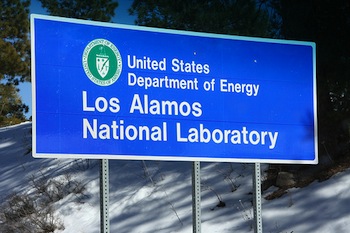I have blogged several times about the accidents and radiation releases at the Waste Isolation Pilot Plant (WIPP) near Carlsbad, New Mexico. The WIPP is the single repository for wastes from nuclear weapons development and manufacture in the U.S. In mid-February of 2014, the contents of a drum from the Los Alamos National Laboratory overheated and caused the drum to burst, raising the temperature in the WIPP chamber to a level that could have caused other drums to rupture. Radioactive materials from the burst drum made their way into the ventilation system which was not functioning properly. Plutonium and americium were detected in Carlsbad, over twenty of miles away. The WIPP had to be shut down which has resulted in hundred of problematic drums of waste being left at LANL, WIPP and in temporary storage in Texas. It will take years to repair the damage from the accident and hundreds of millions of dollars.
The LANL was chasing a deadline of June of 2014 to have sent all of the radioactive waste from nuclear weapons development to the WIPP. If the private consortium could make the deadline, that would help it to get an extension of its two billion dollar annual contract from the U.S. Department of energy. In the summer of 2013, one batch of waste at LANL was found to be far too acidic to be transported to the WIPP. The official policy of LANL called for stopping work with that acidic waste until a specific set of reviews were conducted with respect to how to treat the waste. Such a process is time consuming and expensive and it might have interfered with meeting the June 2014 deadline. Instead of following its own guidelines, the lab and its subcontractors took shortcuts. LANL added a neutralizer to the waste to change its pH and added an organic wheat based kitty litter to absorb excess liquid. One of the subcontractors said that he was not an expert on the chemistry of the wastes at LANL and he requested that LANL experts review the treatment of the waste. This was not done. It turns out that the additives basically turned the contents of the drums of waste into potential bombs.
Drums of the treated acidic waste were shipped to WIPP for permanent disposal. Every drum that is shipped to the WIPP is supposed to be accompanied by documents that give a detailed and complete account of the contents of the drum. The documents that came with the acidic waste drums did not contain the required information. There was no mention of the high acidity, the neutralizer or the organic kitty litter. Most chemists would have recognized the explosive nature of the contents of the drums if they knew that organic kitty litter was being mixed with the nitrate salts in the waste.
For two years before the accident this year, the LANL would not allow inspectors who conducted annual permitting audits for New Mexico's Environmental Department into the area where waste was treated for shipment. The WIPP did not find out about the explosive chemistry in the burst drum until after the accident. Even after the drum burst last February, the LANL continued to withhold critical information from the people at the WIPP. It appears that there may have been a typo in the LANL guidelines that led to the switch to organic kitty litter.
If the documentation for the waste shipments had been accurate and complete, they would not have been allowed on the road at all. The pending report from the National Nuclear Security Administration's Accident Investigation Board is expected to be critical of the behavior of the staff at LANL and their subcontractors who were apparently more interested in meeting the deadline than they were in the safety of the wastes they were shipping. Once again this illustrates a point that I keep repeating. Corporations cannot be relied upon to follow nuclear safety regulations.
